Widex A S DXP D-XP Hearing Aid User Manual 9 514 0217 001 01 indd
Widex A/S D-XP Hearing Aid 9 514 0217 001 01 indd
Manual
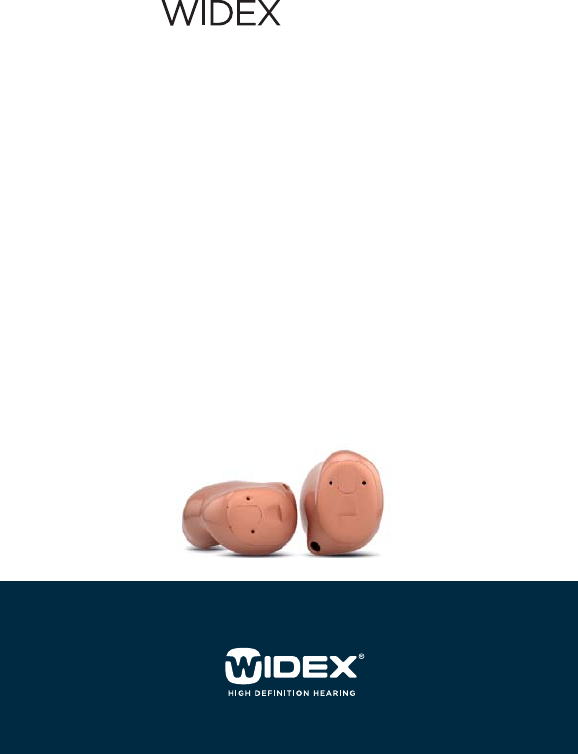
DREAM™
USER INSTRUCTIONS
THE DREAM™ SERIES
D-XP model
In-the-ear
TENTATIVE

2
YOUR WIDEX HEARING AID
(To be filled out by the hearing care professional)
Vent: Vent No vent
DREAM
DREAM
DREAM
DREAM
Programs:
Master Audibility Extender
Music Audibility Extender
TV Audibility Extender
Comfort Audibility Extender
Reverse focus Audibility Extender
Phone Audibility Extender
T Audibility Extender
M+T Audibility Extender
Zen Audibility Extender
Master + Zen Audibility Extender
Master + Reverse focus Audibility Extender
Master + T Audibility Extender
Master + M+T Audibility Extender
Master + Phone Audibility Extender
Zen+ Audibility Extender
Date Your hearing care professional
CONTENTS
SYMBOLS . . . . . . . . . . . . . . . . . . . . . . . . . . . . . . . . . . . . . . . . . .
THEHEARINGAID. . . . . . . . . . . . . . . . . . . . . . . . . . . . . . . . . . .
Acousticindicators . . . . . . . . . . . . . . . . . . . . . . . . . . . . . . . . . . . . .
Thebattery. . . . . . . . . . . . . . . . . . . . . . . . . . . . . . . . . . . . . . . . . . . .
Insertingthebattery . . . . . . . . . . . . . . . . . . . . . . . . . . . . . . . . . .
Lowbatteryindication . . . . . . . . . . . . . . . . . . . . . . . . . . . . . . .
Turningthehearingaidonandoff . . . . . . . . . . . . . . . . . . . . . .
Rightleftidentification. . . . . . . . . . . . . . . . . . . . . . . . . . . . . . . .
Positioningthehearingaid. . . . . . . . . . . . . . . . . . . . . . . . . . . . .
Removingthehearingaid. . . . . . . . . . . . . . . . . . . . . . . . . . . . . .
Volumeadjustment . . . . . . . . . . . . . . . . . . . . . . . . . . . . . . . . . . .
Lostpartneralarm . . . . . . . . . . . . . . . . . . . . . . . . . . . . . . . . . . . .
Programs. . . . . . . . . . . . . . . . . . . . . . . . . . . . . . . . . . . . . . . . . . . . .
Switchingbetweenthelisteningprograms . . . . . . . . . . . . .
Zen. . . . . . . . . . . . . . . . . . . . . . . . . . . . . . . . . . . . . . . . . . . . . . . .
CLEANING. . . . . . . . . . . . . . . . . . . . . . . . . . . . . . . . . . . . . . . . .
Thehearingaid . . . . . . . . . . . . . . . . . . . . . . . . . . . . . . . . . . . . . . .
Thesoundoutlet . . . . . . . . . . . . . . . . . . . . . . . . . . . . . . . . . . . . . .
Themicrophoneopenings . . . . . . . . . . . . . . . . . . . . . . . . . . . . .
Thevent. . . . . . . . . . . . . . . . . . . . . . . . . . . . . . . . . . . . . . . . . . . . . .
NANOCAREWAXGUARD . . . . . . . . . . . . . . . . . . . . . . . . . . .
Changingthewaxguard . . . . . . . . . . . . . . . . . . . . . . . . . . . . . . .
ACCESSORIES . . . . . . . . . . . . . . . . . . . . . . . . . . . . . . . . . . . . .
INCASEOFMALFUNCTION. . . . . . . . . . . . . . . . . . . . . . . . . .
CARINGFORYOURHEARINGAID . . . . . . . . . . . . . . . . . . . .
WARNINGS . . . . . . . . . . . . . . . . . . . . . . . . . . . . . . . . . . . . . . .
ADVICE . . . . . . . . . . . . . . . . . . . . . . . . . . . . . . . . . . . . . . . . . . .
Adaptingtoyourhearingaids . . . . . . . . . . . . . . . . . . . . . . . . . .
REGULATORYINFORMATION . . . . . . . . . . . . . . . . . . . . . . . .
ADDITIONALPROGRAMFORMS. . . . . . . . . . . . . . . . . . . . . .
3

4
SYMBOLS
The following symbols will be used throughout the
manual:
WARNING
Messages with this heading indicate serious adverse reactions,
potential safety hazards and inadequate performance of device.
CAUTION
Messages with this heading indicate/include information regard-
ing any special care to be exercised.
Not for general waste.
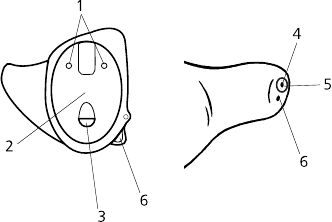
5
THE HEARING AID
1. Microphone openings
2. Battery compartment cover (on/off function)
3. Nail grip
4. Sound outlet
5. NanoCare wax guard
6. Vent (Not in all versions).

6
WARNING
This booklet contains important information and instructions.
Please read this booklet carefully before you start using the
hearing aid.
NOTE
Your hearing aid and accessories may not look exactly as illus-
trated in this booklet. We also reserve the right to make any
changes considered necessary.
7
Intended use
The hearing aids are intended as air conduction amplifi-
cation devices to be used in everyday listening environ-
ments. The hearing aids may be provided with the Zen
program intended to provide a relaxing sound back-
ground (i.e. music/noise source) for adults who desire
to listen to such a background in quiet.
Indications for use
The devices are indicated for individuals with a range of
hearing loss severity from minimal (10 dB HL) to mod-
erately severe (85 dB HL) and all hearing loss configu-
rations.
They are to be programmed by licensed hearing care
professionals (audiologists, hearing aid specialists, oto-
laryngologists) who are trained in hearing (re)habilita-
tion.
Description of device
The hearing aid uses a proprietary wireless technology,
WidexLink, to enable communication between the left
and the right hearing aids, as well as between the hear-
ing aids and the DEX accessories.
Your hearing aid may be provided with a listening pro-
gram called Zen. It makes musical tones (and some-
times a rushing noise) in the background. These sounds
are shaped according to your hearing loss.

8
Acoustic indicators
The hearing aid may be set to produce a signal to indi-
cate the use of certain functions. The signal may be a
spoken message or tones. The signal can also be deac-
tivated.
Functions Default
settings
Other
settings
Adjusting volume via remote control Tone Off
Confirming RC program key use Clicking
sound
Off
Changing program via remote control Message Tones/off
Starting up the hearing aid Message Tone/off
Warning about low battery Message 4 tones/off
Warning about lost partner Off Message
Service reminder Off Message
Note: “Warning about lost partner” can only be made available
in DREAM440.
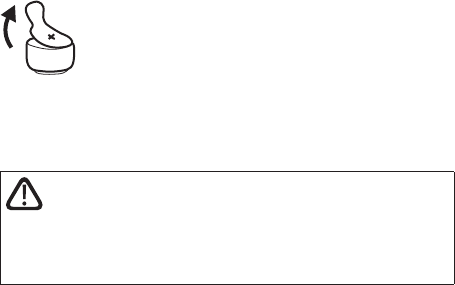
9
The battery
We recommend zinc-air batteries. Use a size 312 bat-
tery for the hearing aid.
To obtain replacement batteries, please consult your
hearing care professional. It is important to take note of
the expiry date and the recommendations on the bat-
tery pack regarding disposal of used batteries. Other-
wise there is a risk that the battery life may be reduced.
Inserting the battery
Before inserting a new battery into the
hearing aid, remember to remove the adhe-
sive tab. Once the tab has been removed,
the battery will start functioning after a few
seconds.
CAUTION
Do not use batteries if there is a sticky residue from the tab or
other unwanted substance, as this can cause the hearing aid to
malfunction.
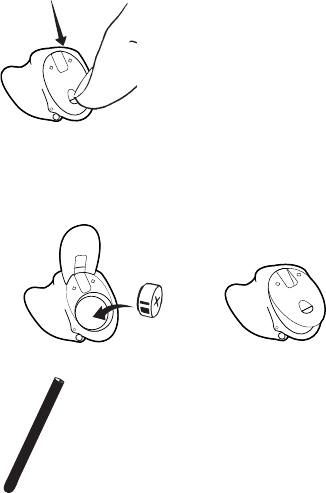
10
Use the nail grip to push the bat-
tery compartment cover downwards
and open the cover. Do not press the
battery compartment cover beyond
the open position.
Place the battery so that the plus (+) sign of the battery
faces upwards.
You can use the battery magnet provided to
steer the battery into place.
If the battery compartment cover does not close easily,
the battery is incorrectly inserted.
When changing battery, it is a good idea to hold the
hearing aid over a table.

11
Low battery indication
An acoustic indicator will sound when the battery is
nearly exhausted, unless this function has been disa-
bled (see page 8). We recommend that you always
have a spare battery with you.
WARNING
Never leave an exhausted battery in the hearing aid. Exhausted
batteries may leak, damaging the hearing aid.
WARNING
Your hearing aid may stop functioning, for instance if the
battery is exhausted. You should be aware of this possibility, in
particular when you are in traffic or are otherwise dependent
on warning signals.
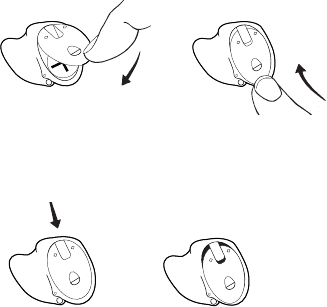
12
Turning the hearing aid on and off
The battery compartment cover of your hearing aid
also functions as the on/off switch.
Close the battery compartment cover and push it
upwards to turn the hearing aid on. An acoustic indica-
tor will indicate that the hearing aid has been switched
on unless this function has been disabled.
Push the battery compartment cover downwards to
turn the hearing aid off.
NOTE: Another way to verify that the hearing aid is
turned on is to cup it in your hand. If it is on, it will whis-
tle.
Please remember to turn off the hearing aid when it is
not in use. Remove the battery if the hearing aid will not
be used for several days.
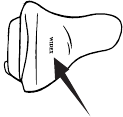
13
Right/left identification
A right-ear hearing aid has a red
Widex logo, and a left-ear hearing aid
a blue logo.
The arrow shows the position of the
logo.

14
Positioning the hearing aid
Close the battery compartment cover completely.
Hold your hearing aid with your
thumb and fore finger. Slowly guide
the hearing aid into your ear canal
until you feel resistance.
Let go of the hearing aid and use
the tip of your forefinger to gen-
tly push it into your ear until it rests
comfortably in your ear canal.
To help position the hearing aid
properly you could pull the outer
ear backwards and upwards with
the opposite hand.
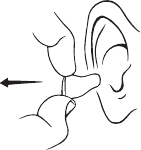
15
Removing the hearing aid
Hold the hearing aid with your
thumb and forefinger and pull gen-
tly.
If it is difficult, you can try to move
the hearing aid carefully from side
to side. It may also help to pull the
outer ear backwards and upwards
with the opposite hand.

16
Volume adjustment
The hearing aid volume is adjusted automatically in ac-
cordance with your sound environment.
If you have a remote control, you can also adjust the
volume manually or mute your hearing aid. Any adjust-
ment of the volume setting will be cancelled when your
hearing aid is turned off, or when you change program.
Depending on hearing aid features and setting, any
change you make will affect both hearing aids.
To alter the increments in which the volume is increased
or decreased, consult your hearing care professional.
If you have a remote control, please also refer to the
user instructions for this.
CAUTION
If the volume in the hearing aid is generally too loud or too
weak, or the reproduced sounds are distorted, or if you would
like any further information, consult your hearing care profes-
sional.
17
To mute the hearing aid with a remote control:
Keep pressing the volume down key on the remote con-
trol after the long beep-tone has sounded and until it
stops. Pressing one of the volume keys briefly will bring
back the sound.
NOTE: Your hearing aid has been set to gradually
increase the amplification provided to allow you to
acclimatize yourself to the sound through the hearing
aid. Therefore you may notice an increase in level after
a period of time.
Lost partner alarm
(Note: Only applicable if this feature is available and
has been activated by your hearing care professional).
If one of your hearing aids falls out of your ear, and/
or the battery is exhausted, a tone signal and a spoken
message will sound two times in the other hearing aid.
Programs
By default your hearing aid has one program. However,
with a remote control a number of additional programs,
plus the special Zen program called Zen+ can be made
available.
Please also refer to the user instructions for your remote
control.

18
Master Standard
Music Forlisteningtomusic
TV ForlisteningtotheTV
Comfort Attenuatesbackgroundnoise
Reverse focus Focusonsoundsfrombehind
Phone Forlisteningtothetelephone
TInthisprogramyoulistenviathetelecoil(T)and
notviathehearingaidmicrophones(M)The
telecoilisusedwherealoopsystemisinstalled
Ifyouactivatethetelecoilprogramyoulistento
aspecificsoundsourceandshutout
surroundingsounds
M+T Inthisprogramyoulistenviathehearingaid
microphones(M)andthetelecoil(T)
Zen Generatesdifferentkindsoftonesornoise
Compound
programs
TheMasterprograminoneearandZen
ReversefocusPhoneTorMTintheother
Zen+ SpecialZenprogramwithuptothreedifferent
Zenstyles
Your hearing aid has a function called the Audibility
Extender. This feature makes high frequency sounds
audible, and can be set to operate for one or more or all
available programs.
If your needs change over time, the combination of lis-
tening programs can be altered.
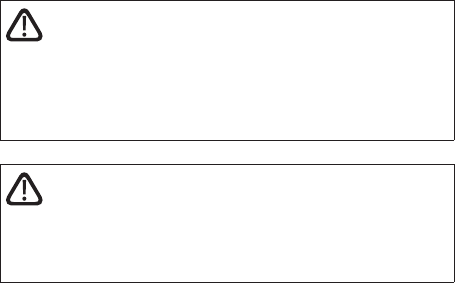
19
Zen program
Your hearing aid may be provided with a unique
optional listening program called Zen. It makes musi-
cal tones (and sometimes a rushing noise) in the back-
ground. The Zen program may be used alone (with-
out amplification) in quiet when you are not required
to hear surrounding sounds. Or, it may be used with
amplification so both the surrounding sounds and the
generated sounds (fractal tones and noise) are heard
together.
CAUTION
Use of the different Zen programs may interfere with hearing
surrounding sounds including speech. The programs should not
be used when hearing such sounds is important. Switch the
hearing aid to a non-Zen program in those situations.
CAUTION
If you perceive decrease in loudness, tolerance of sounds,
speech not as clear, or worsening tinnitus, contact your hearing
care professional.
20
Benefits
The Zen program may provide a relaxing listening
background for some people. When the Zen program
is used in a tinnitus management program, its wearer
may experience some relief from tinnitus.
Indications for use
The Zen program is intended to provide a relaxing
sound background (i.e., music/noise source) for adults
who desire to listen to such a background in quiet. It
may be used as a sound therapy tool in a tinnitus treat-
ment program that is prescribed by a hearing care pro-
fessional (audiologists, hearing aid specialists, otolar-
yngologists) who is trained in tinnitus management.
Directions for use
Because of the unique ways in which Zen is pro-
grammed in your hearing aid, please follow the rec-
ommendations of your hearing care professionals as to
how to use the program, when to use the program and/
or how long to use the program.
21
Switching between the programs
If you have a remote control, you can change programs
with a simple push of the program key. Each time you
change program, an acoustic indicator will sound unless
this function has been disabled.
Program Messageoroneshortbeep
Program Messageortwoshortbeeps
Program Messageorthreeshortbeeps
Program Messageoronelongandoneshortbeep
Program Messageoronelongandtwoshortbeeps
Zen Messageortone
Depending on hearing aid features and setting, any
change you make will affect both hearing aids.
Zen+
This program is accessed via a long press (more than
1 second) on the remote control program key. A short
press then allows you to cycle through the available
Zen styles.
You can exit Zen+ by pressing and holding the program
key for more than 1 second.
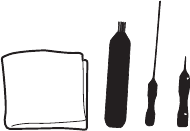
22
CLEANING
The following cleaning accessories are available for the
hearing aid.
1. Cloth
2. Brush
3. Long wax removing tool
4. Short wax removing tool
Contact your hearing care professional if you need
additional supplies of cleaning accessories.
3.2.1. 4.
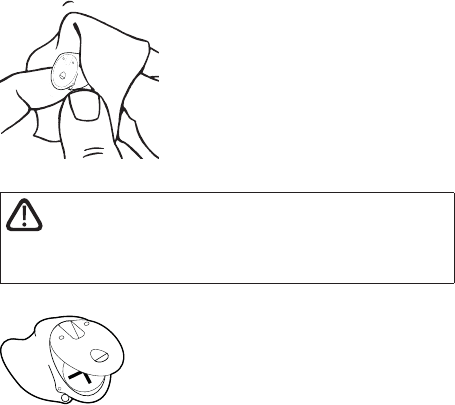
23
The hearing aid
It is very important for the hearing aid’s performance
that it is kept free from earwax and dirt.
Clean your hearing aid after use
with the soft cloth to keep it dry
and clean of earwax or dirt.
WARNING
Never clean the hearing aid with water or cleaning solutions, as
this may cause it to malfunction.
When the hearing aid is not in use, the
battery compartment cover should be
left open to ventilate the hearing aid
and allow it to dry.
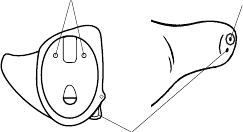
24
We recommend that every time you take the hearing
aid out of your ear, you inspect the sound outlet and
the microphone and vent openings to ensure that no
earwax or dirt has gathered there. Below is an exam-
ple of how the sound outlet and the microphone and
vent openings may be positioned. The positions can be
slightly different on your hearing aid.
1. Sound outlet
2. Vent opening
3. Microphone openings
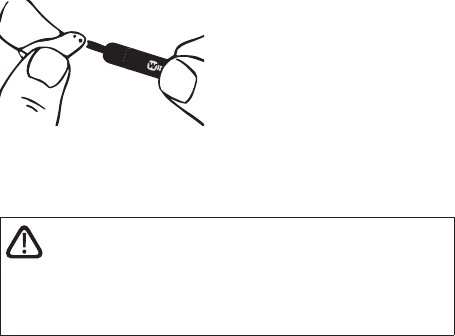
25
The sound outlet
It is important that the sound outlet is not blocked by
earwax.
Remove any visible earwax
from around the sound out-
let with the small brush or
cloth. Do not attempt to
clean the wax guard.
If the sound outlet is still blocked, you should change
the wax guard (see pages 28-31).
WARNING
If you cannot clean the sound outlet completely, you should
contact your hearing care professional. Do not insert anything
into the sound outlet, as this could damage the hearing aid.
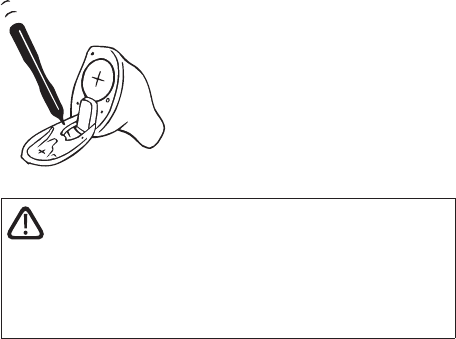
26
The microphone openings
If dirt or earwax has gathered around the microphone
openings on the hearing aid front, do as follows:
Open the battery compartment cover and turn the hear-
ing aid so the cover is facing downwards (see drawing).
Guide the short wax removing
tool (nr. 4) through the micro-
phone opening on the battery
compartment cover from the
inside as illustrated.
WARNING
If you suspect that earwax or dirt has migrated through the mi-
crophone opening and into the actual microphone inside the
hearing aid, contact your hearing care professional. Do not in-
sert anything into the actual microphone.
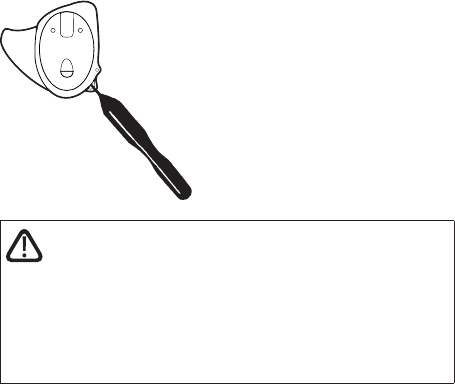
27
The vent
If earwax has accumulated in and/or around the vent
opening, do as follows:
Clean any earwax from the
vent by passing the long wax
removing tool all the way
through the vent.
WARNING
It is important for the performance of the hearing aid that the
vent is never blocked by earwax. Make it a habit to clean the
vent every day! In rare cases so much earwax can accumulate in
the vent that the hearing aid sound is affected. In that case you
should see your hearing care professional.
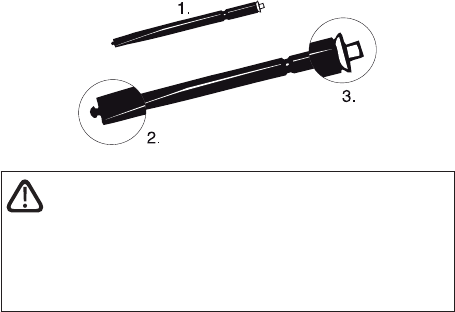
28
NANOCARE WAX GUARD
The NanoCare wax guard helps to protect the hearing
aid against earwax. Always use NanoCare wax guards
with your hearing aid. Otherwise the warranty for your
hearing aid will be void.
The wax guard consists of the following parts:
1. Holder
2. Removal hook
3. Wax guard
CAUTION
The wax guard is disposable and for one-time use only. Do not
attempt to clean or reuse a wax guard. This could damage your
hearing aid and/or cause the wax guard to become dislodged in
your ear.
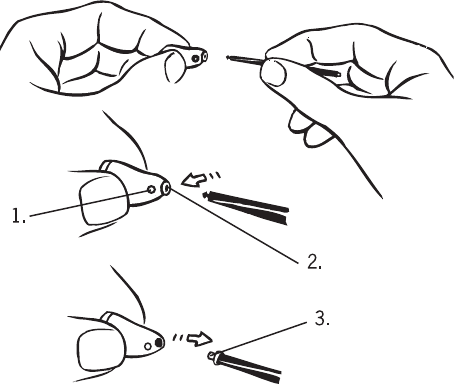
29
Changing the wax guard
Insert the removal hook into the used wax guard placed
in the sound outlet. Pull the wax guard straight out.
1. Vent opening
2. Sound outlet
3. Used wax guard
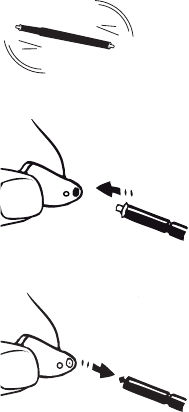
30
Turn the holder around so that the
new wax guard is in position to be
inserted.
Insert the holder into the
opening of the sound out-
let and gently press the wax
guard into the opening.
Then pull the holder straight
out. The new wax guard will
automatically detach from the
holder. Press the hearing aid
gently against a flat surface
to ensure that the wax guard
remains in place.
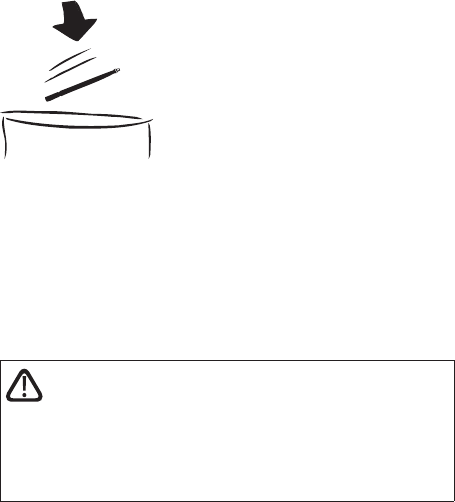
31
Discard the holder with the used
wax guard.
The frequency with which the wax guard should be
changed varies from one individual to another.
If you have any questions regarding your wax guard,
please contact your hearing care professional.
WARNING
If the wax guard fits loosely, discard it and insert another. If the
wax guard becomes dislodged from the hearing aid while in the
ear canal, please contact your physician. Do not try to remove
the wax guard from your ear canal yourself.

32
ACCESSORIES
A variety of assistive listening devices are available for
your hearing aid.
RC-DEX remotecontrol
TV-DEX forlisteningtoTVandaudio
M-DEX formobilephoneapplicationsandremote
control
PHONE-DEX foreasylandlineuse
FM+DEX theFMDEXisahigh-qualitystreamingdevice
designedspecificallyforWidexhearingaids
T-DEX forconnectinghearingaidstomobilephones
usingtelecoil
For help in determining whether you could benefit from
a remote control or other accessories, please consult
your hearing care professional.

33
IN CASE OF MALFUNCTION
The following pages contain some quick advice on what
to do if your hearing aid stops working or performs
unsatisfactorily. If the problems persist, contact your
hearing care professional for assistance.
Problem Possible cause Solution
The hearing
aid is com-
pletely silent
The hearing aid is not
turned on
Make sure the battery is
placed correctly and the
battery compartment
cover is closed correctly.
See page 12
The battery does not
work
Insert a new battery in
the hearing aid
The sound outlet is
blocked
See page 25
The microphone
opening is blocked
See page 26
If you suspect that ear-
wax or dirt has migrated
through the microphone
opening and into the
actual microphone
inside the hearing aid,
contact your hearing
care professional. Do not
insert anything into the
actual microphone.
The hearing
aid volume is
not powerful
enough
The sound outlet is
blocked
See page 25
Your ear is blocked
by earwax
Contact your ENT
doctor/physician
Your hearing may
have changed
Contact your hearing
care professional

34
Problem Possible cause Solution
The hearing
aid whistles
continuously
Your ear is blocked
by earwax
Contact your ENT doc-
tor/physician
The hearing aid is not
correctly placed in
your ear canal
Take the hearing aid out
and reinsert it
The hearing aid fits
loosely in your ear
canal
Contact your hearing
care professional
If the hearing
aid is uncom-
fortable to
wear
The hearing aid is not
correctly placed in
your ear canal.
Consult your hearing
care professional on how
to place the hearing aid
correctly in your ear
canal
Thehearingaiddoes
notfityourear
properly
Contact your hearing
care professional
Your outer ear or ear
canal is sore
It is important that first-
time users only wear the
hearing aid for short
periods of time at the
beginning. The skin in
the ear canal is very thin
and may swell a bit
because of the pressure
from the hearing aid.
Take 2-3 weeks to grad-
ually get used to the
hearing aid. If the sore-
ness continues, contact
your hearing care pro-
fessional
Your hearing
aids are not
working in
synchrony
The connection
between the hearing
aids is lost
Turn the hearing aids off
and on again

35
Problem Possible cause Solution
The hearing
aids do not
respond with a
correspond ing
change in vol-
ume or pro-
gram to the
DEX
a. The DEX is used
beyond the trans-
mission range
b. Strong electro-
magnetic interfer-
ence in the vicinity
c. The DEX and the
DREAM hearing
aids are not
matched
a. Move the DEX closer
to the DREAM hearing
aids
b. Move away from
known source of EM
interference
c. Check with hearing
care professional to
make sure DEX is
matched with DREAM
hearing aids
You hear
“inter rupted”
speech (on
and off) from
the hear ing
aids or no
speech
(muted) from
the transmit-
ting ear.
a. The battery in one
of the hearing aids
has expired
b. Strong electro-
magnetic interfer-
ence in the vicinity
a. Replace battery in one
or both hearing aids
b. Move away from
known sources of
interference

36
CARING FOR YOUR HEARING AID
The hearing aid is a valuable object and should be
treated with care. Here are some things you can do to
prolong the life of your hearing aid:
CAUTION
• Turn off your hearing aid when it is not in use. Remove the
battery if the hearing aid will not be used for several days.
• When the hearing aid is not in use, keep it in its case in a cool,
dry location out of reach of children and pets.
• Do not expose the hearing aid to extreme temperatures or
high humidity. Make sure to dry the hearing aid thoroughly
after heavy perspiration such as that which may occur during
intense physical activity, e.g. playing sports.
• Avoid dropping your hearing aid – perform cleaning and bat-
tery changes while holding the hearing aid above a soft sur-
face.
• Do not wear your hearing aid while in the shower or swim-
ming, or when using a hair dryer, perfume, hair and body
sprays or gels such as suntanning lotions or creams.
• In environments with high humidity, a drying kit may be used
daily to reduce the amount of moisture inside the hearing aid.
See the instructions enclosed with the drying kit.

37
WARNINGS
WARNING
Hearing aids and batteries can be dangerous if swal lowed or
used improperly. Swallowing or improper use can result in
severe injury or even fatalities. In case of ingestion, contact a
physician immediately.
• Keep hearing aids and their parts, accessories and batter-
ies out of reach of children and anyone else who might swal-
low such items or otherwise cause injury to themselves. Do
not change batteries in front of them and do not let them see
where you keep your battery supply. Discard used batteries
carefully.
• Batteries are very small and can easily be mistaken for pills or
the like. Never put a battery or hearing aid in your mouth for
any reason as you may risk swallowing it.

38
WARNING
• Risk of explosion if battery is replaced by an incorrect type or
recharged. Dispose of used batteries according to the instruc-
tions.
• Never allow others to wear your hearing aid, as this could
cause permanent damage to their hear ing.
• When selecting a listening program, please remember that
there are situations in which it is particularly important to be
able to hear the surrounding sounds (e.g. traffic, warning sig-
nals).
• The hearing aid is made of modern non-allergenic materi-
als. Nonetheless, in rare cases skin irritation may occur. If you
notice skin irritation in or around your ear or ear canal, contact
your hearing care professional.
• Please note that when using any type of hearing aid, you must
allow regular ventilation of the ear. If the ear is not adequately
ventilated, there may be a slightly increased risk of infection
or disease in the ear canal. We therefore recommend that you
remove the hearing aid and ear-set from your ear periodically
to allow the ear canal to be ventilated. Make sure that you
clean and inspect your hearing aid and ear-set as required.
If an ear infection or disease occurs, you should seek medi-
cal attention and contact your hearing care professional for
advice on how to disinfect the various hearing aid parts. Do
not under any circumstances use alcohol, chlorine or similar
substances for this purpose.
• Do not use Widex hearing aids in mines or other areas with
explosive gases.
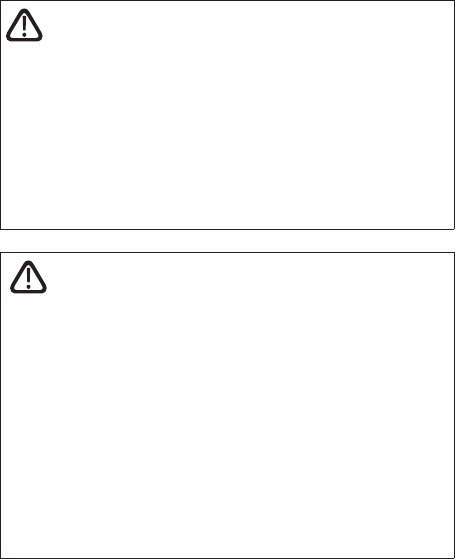
39
WARNING
• Do not wear your hearing aid during radiation, X-rays, MRIs,
CT or other medical treatments and scans. The emissions
from these procedures as well as from other types of radia-
tion, such as that in a microwave oven, can damage your hear-
ing aid. Radiation from, for example, room surveillance equip-
ment, burglar alarms and mobile phones is weaker and will
not damage the hearing aid, but may create audible interfer-
ence.
CAUTION
• Your hearing aid has been tested for interference according
to international standards. Nevertheless, it is possible that
unforeseen interference may occur in the hearing aid due to
electromagnetic radiation from other products such as alarm
systems, room surveillance equipment and mobile phones.
• Although your hearing aid has been designed to comply with
the most stringent international electromagnetic compatibil-
ity standards, the possibility cannot be excluded that it may
cause interference with other equipment, such as medical
devices.
• Never try to open or repair the hearing aid yourself.

40
ADVICE
NOTE
• The hearing aid will not restore normal hearing and will not
prevent or improve a hearing loss resulting from organic
conditions. However, the hearing aid can help you to make
the best possible use of your remaining hearing ability. You
should also bear in mind that it can take time to get used to a
new hearing aid and new sounds.
• In most cases, using the hearing aid infrequently will not per-
mit you to gain full benefit from it.
• The use of a hearing aid is only part of hearing habilitation
and may need to be supplemented by auditory training and
instruction in lipreading.
• The use of hearing aids increases the risk of accumulation of
earwax. Contact your physician/ENT doctor if you suspect
that a plug of earwax has accumulated in your ear. Earwax
may not only reduce your own hearing but also the effect of
the hearing aid considerably. It is a good idea to ask your phy-
sician to clean your ears a couple of times a year.
41
Adapting to your hearing aids
Congratulations for taking the first steps toward re-
storing your communication skills with the purchase of
state-of-the-art hearing aids from Widex.
Because many of the sounds you may now hear have
not been fully audible without hearing aids, we urge
you to take a few minutes to perform the following sim-
ple activities in the order listed. Do these first in quiet
settings, then try them in noisier surroundings.
Activity 1: First, listen to a friend or relative speak to
you with your eyes closed and your hearing aids off.
Now, put your hearing aids on and continue to listen.
Notice the difference? The purpose of this activity is not
to hear every word, but just to recognize the difference
in amplified speech from a familiar source.
Activity 2: Listen to your friend or relative speak to you
with your hearing aids on, but with your eyes closed.
Now continue to listen with your eyes open. The goal is
to demonstrate how helpful it is to receive information
from your eyes to supplement your ears.
Activity 3: Purchase two copies of today’s newspaper.
Ask a friend or relative to read a story aloud while you
read along with the same story. Alternatively, read it
aloud and listen to your own voice. It is also helpful to
watch captioned TV.
42
• We hear in our brain, not in our ears. It will take your
brain some time to fully adapt to the new sounds
you are hearing. It is not unusual, for example, to
hear certain sounds, such as your own footsteps, or
a newspaper rustling, or the refrigerator humming,
that people with normal hearing take for granted and
thus don’t consciously process. Be patient and allow
yourself a few weeks to adapt. Your brain will learn
to ignore them if they are not important. Of course,
if sounds are too loud or uncomfortable for you, con-
tact your hearing care professional.
• Conversational speech has many redundant cues.
Worrying about a word you may have missed will
likely lead to additional missed words. Focus on the
essence of the conversation. It may help to ask some-
one you are comfortable with to subtly alert you
about the overall topic when listening in groups.
• Before going to a restaurant, call ahead and request
a seat away from the kitchen or bar area. Remember
that in noisy places, even normal hearing people may
struggle to hear.
For more activities, training materials, and helpful com-
munication hints please go to www.widex.com.
43
REGULATORY INFORMATION
FCC ID: TTY-DXP
IC: 5676B-DXP
Federal Communications Commission Statement
This device complies with part 15 of the FCC Rules. Operation is
subject to the following two conditions:
(1) This device may not cause harmful interference, and
(2) this device must accept any interference received, including
interference that may cause undesired operation.
NOTE:
This equipment has been tested and found to comply with the
limits for a Class B digital device, pursuant to part 15 of the FCC
Rules. These limits are designed to provide reasonable protec-
tion against harmful interference in a residential installation.
This equipment generates, uses and can radiate radio frequency
energy and, if not installed and used in accordance with the
instructions, may cause harmful interference to radio communi-
cations. However, there is no guarantee that interference will not
occur in a particular installation. If this equipment does cause
harmful interference to radio or television reception, which can
be determined by turning the equipment off and on, the user is
encouraged to try to correct the interference by one or more of
the following measures:
— Reorient or relocate the receiving antenna.
— Increase the separation between the equipment and receiver.
— Connect the equipment into an outlet on a circuit different
from that to which the receiver is connected.
— Consult the dealer or an experienced radio/TV technician for
help.
44
NOTE:
This equipment complies with FCC radiation exposure limits set
forth for an uncontrolled environment. This transmitter must not
be co-located or operating in conjunction with any other
antenna or transmitter.
Changes or modifications to the equipment not expressly
approved by Widex could void the user’s authority to operate
the equipment.
Industry Canada Statement /
Déclaration d’industrie Canada
Under Industry Canada regulations, this radio transmitter may
only operate using an antenna of a type and maximum (or
lesser) gain approved for the transmitter by Industry Canada.
To reduce potential radio interference to other users, the
antenna type and its gain should be so chosen that the equiva-
lent isotropically radiated power (e.i.r.p.) is not more than that
necessary for successful communication.
This device complies with Industry Canada licence-exempt RSS
standard(s). Operation is subject to the following two condi-
tions:
(1) this device may not cause interference, and
(2) this device must accept any interference, including interfer-
ence that may cause undesired operation of the device.
Conformément à la réglementation d’Industrie Canada, le
présent émetteur radio peut fonctionner avec une antenne d’un
type et d’un gain maximal (ou inférieur) approuvé pour
l’émetteur par Industrie Canada.
Dans le but de réduire les risques de brouillage radioélectrique à
l’intention des autres utilisateurs, il faut choisir le type d’antenne
et son gain de sorte que la puissance isotrope rayonnée équiva-
lente (p.i.r.e.) ne dépasse pas l’intensité nécessaire à
l’établissement d’une communication satisfaisante.
45
Le présent appareil est conforme aux CNR d’Industrie Canada
applicables aux appareils radio exempts de licence.
L’exploitation est autorisée aux deux conditions suivantes :
(1) l’appareil ne doit pas produire de brouillage, et
(2) l’utilisateur de l’appareil doit accepter tout brouillage radioé-
lectrique subi, même si le brouillage est susceptible d’en com-
promettre le fonctionnement.
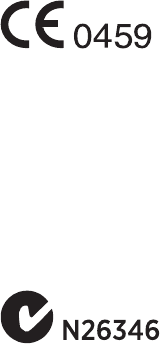
46
Hereby, Widex A/S declares that this D-XP is in compli-
ance with the essential requirements and other relevant
provisions of Directive 1999/5/EC.
A copy of the Declaration of Conformity can be found
at: http://www.widex.com

47
Hearing aids, accessories and batter-
ies should not be disposed of with nor-
mal household waste. Please consult your
national Widex distributor for advice on
how to dispose of these items.

48
ADDITIONAL PROGRAM FORMS
Programs available in your hearing aid:
Program 1:
Program 2:
Program 3:
Program 4:
Program 5:
Special program:

49
Programs available in your hearing aid:
Program 1:
Program 2:
Program 3:
Program 4:
Program 5:
Special program:
50
51
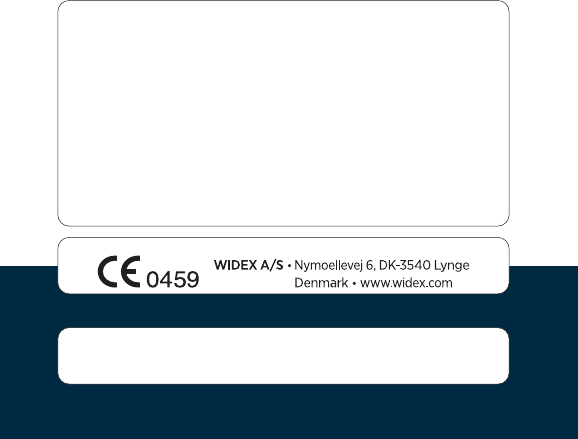
¡9 514 0132 001S¤ Printed by HTO / 2012-04
9 514 0217 001 #01
¡#01v¤
Manufacturer